GEMSTONES
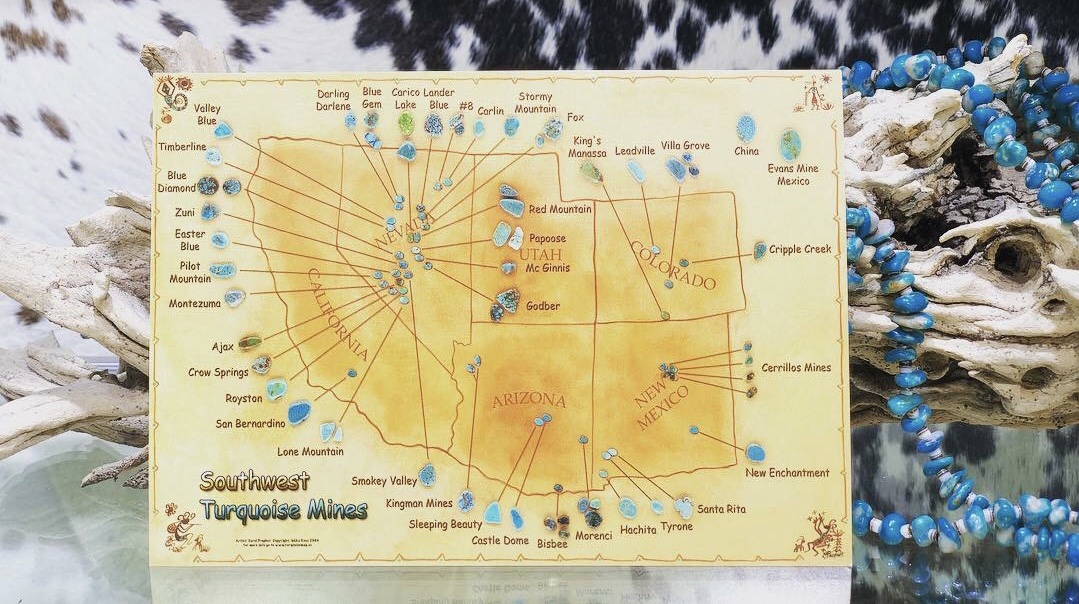 One of the most historic gemstones in the world, Turquoise, is not limited to greenish-blue color, but this mineral has been mined in hues of blue, green, and yellow. Just like diamonds, they are valued in different grades, hardness, clarity, origin, and whether they are light, dark or framed with matrix from the host rock.
One of the most historic gemstones in the world, Turquoise, is not limited to greenish-blue color, but this mineral has been mined in hues of blue, green, and yellow. Just like diamonds, they are valued in different grades, hardness, clarity, origin, and whether they are light, dark or framed with matrix from the host rock.
Raw natural turquoise is found in dry climates all around the world. Although the turquoise from Iran was always known for the most valued turquoise, collectors are finding the turquoise made in the Southwest to be the most valued in the world. Natural turquoise is a hydrous phosphate formed through a chemical reaction from minerals that leak into the cracks of the rocks and turn into a clump of turquoise. Different minerals make up different colors of turquoise. The copper is what gives turquoise a blue color and the green is associated with the iron content. If the turquoise contains the mineral zinc, it becomes a yellowish color.
There’s no evidence when turquoise was first discovered but there are many beliefs, habits and folklore developed throughout history of mankind. Turquoise relates to good luck like a rabbits foot and has become a person or tribe’s symbol of origin, happiness, power, safety, or wealth.
Bisbee Turquoise
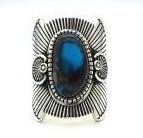 First discovered in the 1800s, the Bisbee turquoise mine, near Bisbee, Arizona, is one of the more famous of the American mines because Bisbee turquoise was one of the first put onto the market. The turquoise mine is part of the Bisbee copper mine. Bisbee turquoise has developed a reputation as a hard, finely webbed, strikingly brilliant blue stone of a high quality. The unusual matrix forms wisps or veils throughout the stone, often called “Smoky Bisbee.” Phelps Dodge Mining Company declared Bisbee depleted and buried the mine under 50 feet of dirt.
First discovered in the 1800s, the Bisbee turquoise mine, near Bisbee, Arizona, is one of the more famous of the American mines because Bisbee turquoise was one of the first put onto the market. The turquoise mine is part of the Bisbee copper mine. Bisbee turquoise has developed a reputation as a hard, finely webbed, strikingly brilliant blue stone of a high quality. The unusual matrix forms wisps or veils throughout the stone, often called “Smoky Bisbee.” Phelps Dodge Mining Company declared Bisbee depleted and buried the mine under 50 feet of dirt.
Boulder Turquoise
 Boulder turquoise, or sometimes called Royston ribbon comes from the Royston district range in Nevada. This area produces some of the most spectacular and sought after turquoise in the world. Boulder turquoise is actually what the miners call “saw rock”. The hard rock is cut to study the vein for color, quality, size of formation, and usability. Only recently have Navajo silversmiths added this beautiful stone to the southwestern American Indian jewelry market. Boulder turquoise is known for both its beauty and rarity.
Boulder turquoise, or sometimes called Royston ribbon comes from the Royston district range in Nevada. This area produces some of the most spectacular and sought after turquoise in the world. Boulder turquoise is actually what the miners call “saw rock”. The hard rock is cut to study the vein for color, quality, size of formation, and usability. Only recently have Navajo silversmiths added this beautiful stone to the southwestern American Indian jewelry market. Boulder turquoise is known for both its beauty and rarity.
Black Jade
 Black jade is found in California and Wyoming. It is becoming more popular in Native American inlay jewelry as a replacement for black jet due to its hardness and high luster. Black jade has a hardness of 6 on the Moh’s scale which makes it a very durable stone. The color comes from high amounts of iron and/or graphite. Black Jade is an important tool for looking inward. It allows for honest self-evaluation and helps absorb and transform unhealthy and destructive emotions.
Black jade is found in California and Wyoming. It is becoming more popular in Native American inlay jewelry as a replacement for black jet due to its hardness and high luster. Black jade has a hardness of 6 on the Moh’s scale which makes it a very durable stone. The color comes from high amounts of iron and/or graphite. Black Jade is an important tool for looking inward. It allows for honest self-evaluation and helps absorb and transform unhealthy and destructive emotions.
Black Onyx
 The name comes from the Greek word which means nail of a finger or claw. Onyx is found in Arizona, Mexico and Algeria. It is a banded variety of chalcedony. The colors of its bands range from white to almost every color (save some shades, such as purple or blue). Commonly, specimens of onyx contain bands of black and/or white. It has a hardness of 6.5-7 on the Moh’s scale. Onyx is believed to bring rejuvenation when feeling depleted of energy. A powerful gemstone to use in difficult or confusing times of our lives as it grounds us, keeping us focused and on task. It is also known to bring happiness, and heighten one’s intuition and instinct. Onyx is the mystical birthstone for December.
The name comes from the Greek word which means nail of a finger or claw. Onyx is found in Arizona, Mexico and Algeria. It is a banded variety of chalcedony. The colors of its bands range from white to almost every color (save some shades, such as purple or blue). Commonly, specimens of onyx contain bands of black and/or white. It has a hardness of 6.5-7 on the Moh’s scale. Onyx is believed to bring rejuvenation when feeling depleted of energy. A powerful gemstone to use in difficult or confusing times of our lives as it grounds us, keeping us focused and on task. It is also known to bring happiness, and heighten one’s intuition and instinct. Onyx is the mystical birthstone for December.
Blue Lapis
 Lapis lazuli or blue lapis is a relatively rare semiprecious stone and comes mainly out of Afghanistan and has been mined for its beauty for over 6 thousand years. You will find pyrite mixed in with lapis and this stone takes an excellent polish. It is said lapis has a calming effect on the central nervous system.
Lapis lazuli or blue lapis is a relatively rare semiprecious stone and comes mainly out of Afghanistan and has been mined for its beauty for over 6 thousand years. You will find pyrite mixed in with lapis and this stone takes an excellent polish. It is said lapis has a calming effect on the central nervous system.
Boulder Creek Turquoise
Boulder turquoise, or sometimes called Royston ribbon comes from the Royston district range in Nevada. This area produces some of the most spectacular and sought after turquoise in the world. Boulder turquoise is actually what the miners call “saw rock”. The hard rock is cut to study the vein for color, quality, size of formation, and usability. Only recently have Navajo silversmiths added this beautiful stone to the southwestern American Indian jewelry market. Boulder turquoise is known for both its beauty and rarity.
Broken Arrow
Broken Arrow is a veracite and the mine is located in Esmerelda County, Nevada. The mine has only been open since Oct. of 2005. Owned by David Otteson, it produces two-tone greens with some blues. This is a very hard material (6.5 to 7.5 hardness) that takes a excellent shine
Candelaria Turquoise
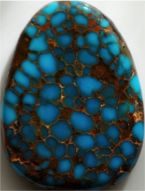 In 1864 Mexican prospectors discovered silver which is now 50 miles west of Tonopah, in Mineral County Nevada and they named the site Candelaria. It is mainly a gold and silver mine. The turquoise found in this mine usually runs in thin veins. This turquoise is a good quality stone of high blue color with intermittent black to brown matrix and webbing. This mine closed and is seldom found in jewelry which makes it very collectable.
In 1864 Mexican prospectors discovered silver which is now 50 miles west of Tonopah, in Mineral County Nevada and they named the site Candelaria. It is mainly a gold and silver mine. The turquoise found in this mine usually runs in thin veins. This turquoise is a good quality stone of high blue color with intermittent black to brown matrix and webbing. This mine closed and is seldom found in jewelry which makes it very collectable.
Carico Lake Turquoise
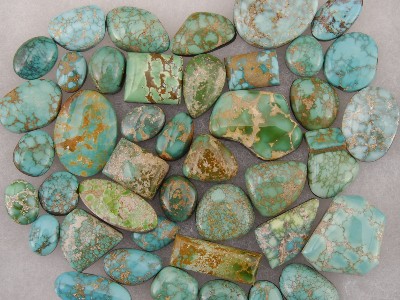 The Carico Lake mine is located 35 miles South of Battle Mountain in Lander County, Nevada. It is known for its “spring green color” which is due to a high copper and zinc content. This mine also produces a deep blue with a matrix of mostly limonite. Carico Lake Turquoise was first mined by Native Americans prior to the 1500s evidenced by the ancient stone tools. This turquoise is coveted by collectors and is used by many award winning Native American artists including Gary Reeves, Albert Jake and Terry Martinez.
The Carico Lake mine is located 35 miles South of Battle Mountain in Lander County, Nevada. It is known for its “spring green color” which is due to a high copper and zinc content. This mine also produces a deep blue with a matrix of mostly limonite. Carico Lake Turquoise was first mined by Native Americans prior to the 1500s evidenced by the ancient stone tools. This turquoise is coveted by collectors and is used by many award winning Native American artists including Gary Reeves, Albert Jake and Terry Martinez.
Charolite
Charoite was first discovered in the 1940s. It was introduced in the U.S. from the Charo River area in Siberia in 1976. It is a lavender to deep purple color and can include swirl and silky zones or needle like patterns. It is a hydrous silicate of sodium, calcium, and potassium and is fairly hard. Charoite has been used notonly in jewelry, but as inlay in furniture. Used by political prisoners held in the area Charoite is a source of comfort and a symbol of endurance in adversity.
Dry Creek Turquoise
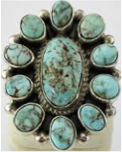 Dry Creek Turquoise, also known as Sacred Buffalo is a natural turquoise and was first discovered in 1993 on the Shoshone reservation in Nevada. They began using it in jewelry in 1996. Copper gives turquoise a blue color and iron green. Due to the lack of either in the mountain makes this stone very light in color and unique from other turquoise. This turquoise goes very well with skin tones which makes it one of the most sought after. To date, no other vein of this turquoise has been discovered anywhere else. It is becoming harder to find and when this current vein runs out, that will be the last of it.
Dry Creek Turquoise, also known as Sacred Buffalo is a natural turquoise and was first discovered in 1993 on the Shoshone reservation in Nevada. They began using it in jewelry in 1996. Copper gives turquoise a blue color and iron green. Due to the lack of either in the mountain makes this stone very light in color and unique from other turquoise. This turquoise goes very well with skin tones which makes it one of the most sought after. To date, no other vein of this turquoise has been discovered anywhere else. It is becoming harder to find and when this current vein runs out, that will be the last of it.
Fox Turquoise
The Fox Turquoise mine, located near Lander County and discovered in the early 1900’s, was once Nevada’s largest producer of turquoise with some half million pounds. At that time, Mr. Dowell Ward, the mine operator, amassed one of the largest collections of turquoise rock. This mine has been closed for quite some time.
In prehistoric times, indigenous peoples mined turquoise and found large nuggets. The different sites of Fox deposits were developed using the names of Fox, White Horse, Green Tree, and Smith to differentiate among the colors of turquoise produced in the area, and to create a larger perceived share of the turquoise market. Collectively, the area produces a huge quantity of good-quality green or blue-green stone with a distinctive matrix. Blue Fox turquoise is more accurately known as “White Horse Fox,” as that is the area of Lander County where the blue variation has been found. The Fox mine has also been known as the Cortez mine.
Gaspeite
![]() Gaspeite is a relatively rare mineral and was discovered in 1966. Its light green, almost apple green color is quite unique and some varieties are almost neon green. It may contain brownish patches which give it a distinctive character. Gaspeite is found around nickel sulfide deposits and is named for the locality of Gaspe Peninsula, Quebec, Canada where it was originally found. Sources are Canada and Western Australia. Hardness is 4.5 – 5 on the Mohs scale.
Gaspeite is a relatively rare mineral and was discovered in 1966. Its light green, almost apple green color is quite unique and some varieties are almost neon green. It may contain brownish patches which give it a distinctive character. Gaspeite is found around nickel sulfide deposits and is named for the locality of Gaspe Peninsula, Quebec, Canada where it was originally found. Sources are Canada and Western Australia. Hardness is 4.5 – 5 on the Mohs scale.
Gilson Opal
This type of gemstone is created in controlled laboratory conditions. They have the same chemical composition and physical properties to that of the natural gemstones. Various methods are used to create synthetic gemstones. Some of these processes can be very expensive. Sometimes a Lab Created gemstone can even cost more than the natural stone. For the most part these processes provide us with excellent looking gems at a more affordable price.
Ithaca Peak Turquoise
The Ithaca Peak Turquoise mine was discovered in 1906. It is located approximately 1/4 mile north of the Kingman Turquoise mine and 14 miles northwest of Kingman, Arizona. As with most turquoise mines, this is a copper mine and turquoise is a secondary mineral. Some of the stone has a very rare “Birds Eye” pattern. Mining at this location stopped many years ago, but recently became operational again.
Kingman Turquoise
The Kingman turquoise mine is located about 14 miles Northwest of Kingman, AZ. It was first mined by the Hohokam Indians 1,400 years ago. It is one of 3 sites of prehistoric mining located in the state of Arizona and this was the most extensively worked of the three. This mine began to be commercially worked in the 1880s as a copper mine. It produces a wide variety of colors of turquoise from pure blue to green with a brown or black matrix.
Kings Manassa Turquoise
King’s Manassa turquoise is mined at Manassa in south central Colorado, but began its mining days first began with the Ancient Pueblo Indians. The Manassa mine is also known as King’s Manassa or the King’s Mine. I.P. King discovered this vein of turquoise while looking for gold in the 1890s. After mining for a while, he soon abandoned the mine after seeing that there wasn’t very much gold, only some strange blue rocks that he took back to his home. He didn’t realize that these stones were valuable until a friend asked about them. Manassa turquoise is known for its blue-green to green color with a golden or brown, non-webbed matrix. The golden matrix comes from the host rock, rhyolite. The Manassa mine is still in production, and owned by the King family.
Larimar
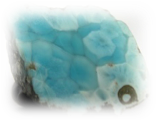 In 1974, at the foot of the Bahoruco Range in the Dominican Republic a man named Miguel Méndez and Peace Corps volunteer Norman Rilling discover Larimar on a beach. Natives, who believed the stone came from the sea, called the gem Blue Stone. Miguel took his young daughter’s name Larissa and the Spanish word for sea (mar) and formed Larimar, by the colors of the water of the Caribbean Sea, where it was found. Larimar is a volcanic rock, is only found in the Dominican Republic and has a hardness of 4.5-5 on Moh’s scale.
In 1974, at the foot of the Bahoruco Range in the Dominican Republic a man named Miguel Méndez and Peace Corps volunteer Norman Rilling discover Larimar on a beach. Natives, who believed the stone came from the sea, called the gem Blue Stone. Miguel took his young daughter’s name Larissa and the Spanish word for sea (mar) and formed Larimar, by the colors of the water of the Caribbean Sea, where it was found. Larimar is a volcanic rock, is only found in the Dominican Republic and has a hardness of 4.5-5 on Moh’s scale.
Malachite
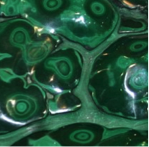 Malachite is a green copper carbonate hydroxide mineral.
Malachite is a green copper carbonate hydroxide mineral.
It was one of the first ores used to produce copper metal. Malachite has been used as a gemstone and sculptural material for thousands of years and is still popular today. Today it is most often cut into cabochons or beads for jewelry use. Malachite has a green color that does not fade over time or when exposed to light. Those properties, along with its ability to be easily ground to a powder, made malachite a preferred pigment and coloring agent for thousands of years.
Morenci Turquoise
The Morenci Turquoise is located in southeastern Arizona. This mine was a large producer of turquoise which was used in Southwest Native American Jewelry. It is high to light blue in color. Morenci has an unusual matrix of irregular black pyrite that, when polished, often looks like silver. Morenci turquoise is well known because it was one of the first American turquoise to come on the market. It is very difficult to obtain now because the mine has been depleted for many years and is a very collectible turquoise.
Mother of pearl
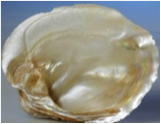 Mother of pearl is the common name for iridescent nacre, a blend of minerals that are secreted by oysters and other mollusks and deposited inside their shells, coating and protecting them from parasites and foreign objects. Nacre is the same substance that is deposited around an object that becomes lodged in the mollusk–either naturally or inserted by humans to become a pearl. Mother of pearl is very hard, iridescent and durable.
Mother of pearl is the common name for iridescent nacre, a blend of minerals that are secreted by oysters and other mollusks and deposited inside their shells, coating and protecting them from parasites and foreign objects. Nacre is the same substance that is deposited around an object that becomes lodged in the mollusk–either naturally or inserted by humans to become a pearl. Mother of pearl is very hard, iridescent and durable.
Number 8 Turquoise
 The Number 8 turquoise mine located in Eureka County, Nevada was first mined in 1929. In its prime, #8 produced some of the largest nuggets of turquoise found. With a spider web matrix of colors ranging from golden brown to black set off the unique bright powder blue background of the stone. Number 8 turquoise has been coveted by collectors and used by top Native American jewelers. The owners removed the turquoise from this mine in 1976 and have been releasing it over the years.
The Number 8 turquoise mine located in Eureka County, Nevada was first mined in 1929. In its prime, #8 produced some of the largest nuggets of turquoise found. With a spider web matrix of colors ranging from golden brown to black set off the unique bright powder blue background of the stone. Number 8 turquoise has been coveted by collectors and used by top Native American jewelers. The owners removed the turquoise from this mine in 1976 and have been releasing it over the years.
Picture Jasper
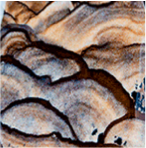 Picture Jasper is found in Utah and is a remarkable form of Brown Jasper. It is characterized by masterful “scenes” and landscape patterns formed by Nature, and is believed to contain hidden messages from the past. It was revered in many cultures of the world for its deep connection to the Earth, its protection during shamanic journeying, and its ability to divine the land and the future. It is perhaps more closely connected to the planet than any other Jasper and is known today as the Stone of Global Awareness.
Picture Jasper is found in Utah and is a remarkable form of Brown Jasper. It is characterized by masterful “scenes” and landscape patterns formed by Nature, and is believed to contain hidden messages from the past. It was revered in many cultures of the world for its deep connection to the Earth, its protection during shamanic journeying, and its ability to divine the land and the future. It is perhaps more closely connected to the planet than any other Jasper and is known today as the Stone of Global Awareness.
Pilot Mountain Turquoise
The Pilot Mountain mine is located a short distance outside of Tonopah, Nevada at the southern end of the Pilot Mountain range. Pilot Mountain turquoise was first mined around 1930 as a tunnel mine. While Pilot Mountain is considered an active mine, it is a very small operation. The miners go to the mine twice per year, bringing out only about 150 to 200 lbs. of rough stone each time. Pilot Mountain turquoise is highly admired for its deep blue-green color variations. Pilot Mountain turquoise is a hard stone that takes a good polish.
Pipestone
 Pipestone is a type of argillite which is metamorphosed mudstone usually brownish-red in color, which occurs in a matrix of Sioux Quartzite. Because it is fine-grained and easily worked, it is prized by Native Americans, primarily those of the Plains nations for use in making ceremonial pipes. Pipestone quarries are located and preserved in Pipestone National Monument outside Pipestone, Minnesota, in Pipestone County, Minnesota, and at the Pipestone River in Ontario, Canada.
Pipestone is a type of argillite which is metamorphosed mudstone usually brownish-red in color, which occurs in a matrix of Sioux Quartzite. Because it is fine-grained and easily worked, it is prized by Native Americans, primarily those of the Plains nations for use in making ceremonial pipes. Pipestone quarries are located and preserved in Pipestone National Monument outside Pipestone, Minnesota, in Pipestone County, Minnesota, and at the Pipestone River in Ontario, Canada.
Red Italian Sea Coral
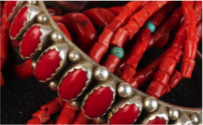 Red coral is a collection of hundreds of tiny animals living together in colonies that resemble small leafless bushes growing on dark, rocky sea bottoms from 100 to 400 feet down. Southwest Native Americans first began using red coral in the 1930s. The original species is found mainly in the Mediterranean Sea. Due to over harvesting, restrictions have been placed on the amount that can be removed each year.
Red coral is a collection of hundreds of tiny animals living together in colonies that resemble small leafless bushes growing on dark, rocky sea bottoms from 100 to 400 feet down. Southwest Native Americans first began using red coral in the 1930s. The original species is found mainly in the Mediterranean Sea. Due to over harvesting, restrictions have been placed on the amount that can be removed each year.
Rhodochrosite
Rhodochrosite is a manganese carbonate material and is the Colorado state mineral although most rhodochrosite mined comes from Argentina. It is found from red to pink with white stripes running thru it and it has a hardness of 3.5 to 4 on the Moh’s scale. Rhodochrosite is said to attract love to the wearer, has a positive effect on the eyesight and helps in letting go of psychological baggage.
Royston Turquoise
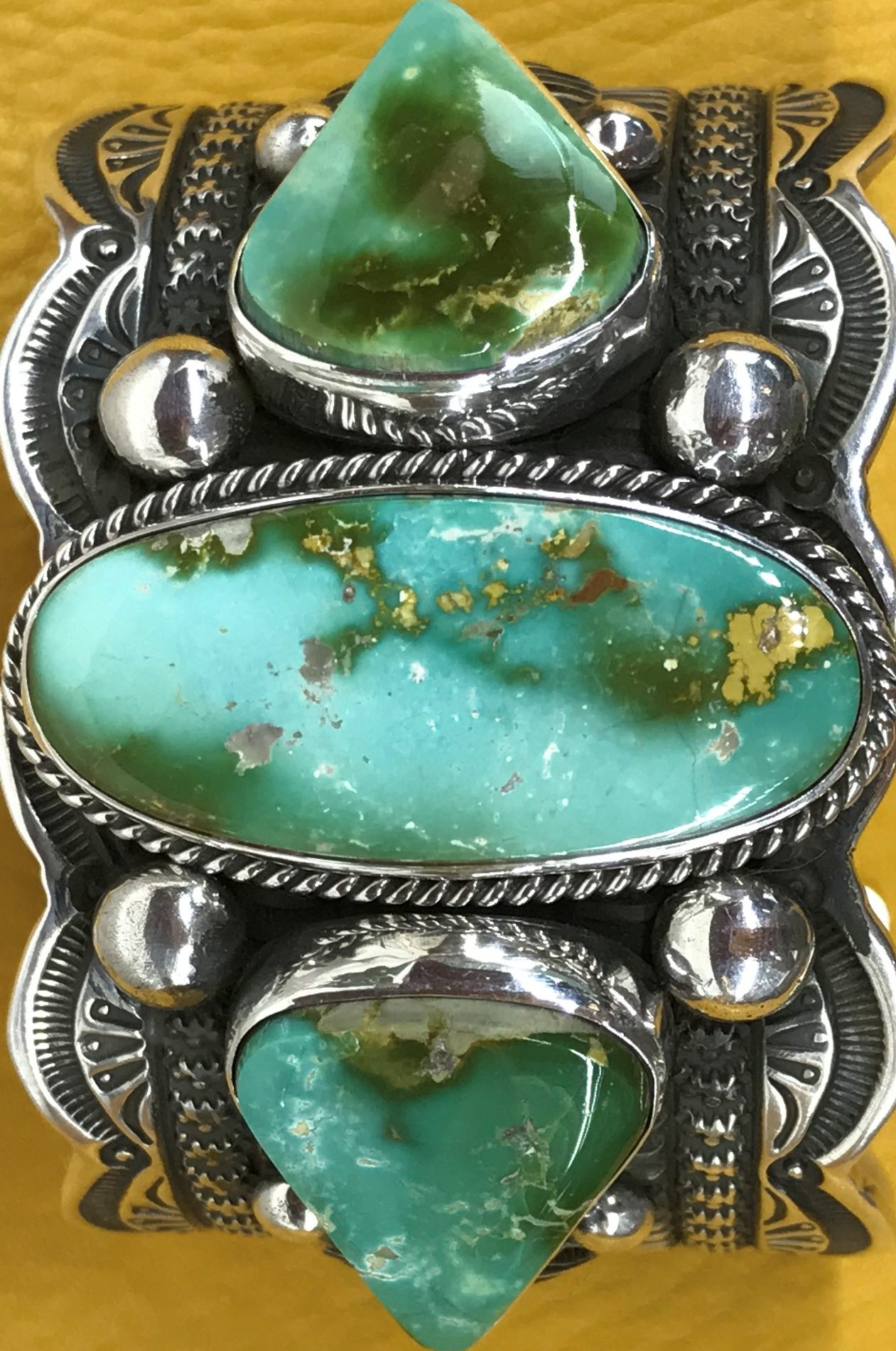 Royston is located within the Royston District in the southwestern part of Nevada. It was discovered in 1902. While it is considered an active mine, it is a very small operation. It is a good producer of high quality stones. Royston turquoise is known for its beautiful deep green to rich light blue colors. These unique color ranges are what make this stone so special. Royston stones are often two-tone, displaying both dark and light green and sometimes blue. Royston has a heavy matrix ranging from dark brown to gold in color.
Royston is located within the Royston District in the southwestern part of Nevada. It was discovered in 1902. While it is considered an active mine, it is a very small operation. It is a good producer of high quality stones. Royston turquoise is known for its beautiful deep green to rich light blue colors. These unique color ranges are what make this stone so special. Royston stones are often two-tone, displaying both dark and light green and sometimes blue. Royston has a heavy matrix ranging from dark brown to gold in color.
Sleeping Beauty Turquoise
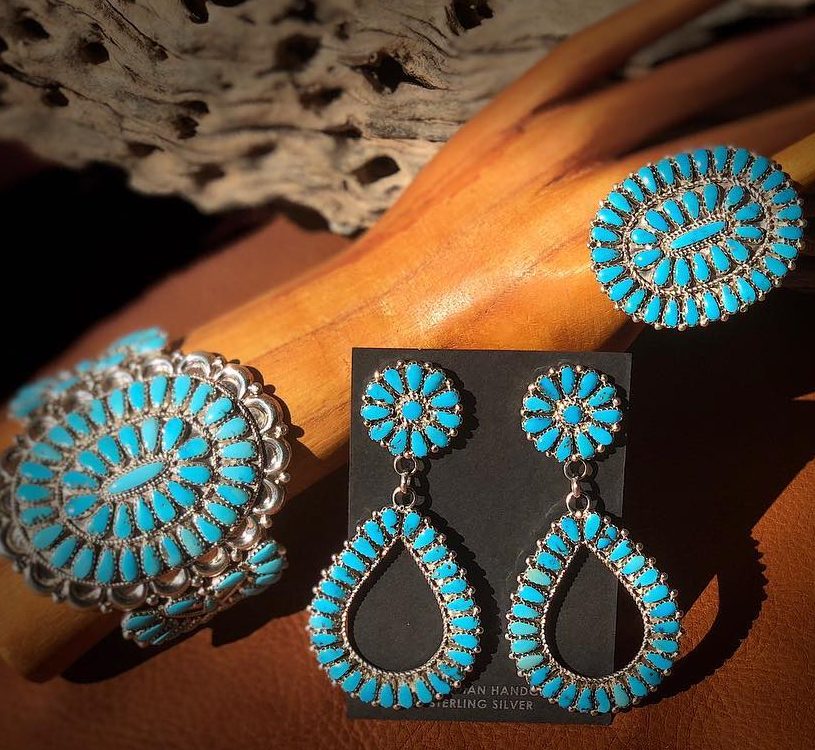 The Sleeping Beauty mine is named after the range of mountains which look like a maiden in slumber. They are located in Miami, Arizona, near Globe. The Sleeping Beauty mine produces light to dark blue turquoise with no to black matrix. It is usually found in granite and is very easy to work with. Silversmiths in the Southwest commonly use it in inlay jewelry especially the Zuni Indians who also incorporate it into their petit point and needle point jewelry. It is one of the largest mines in America and is generally affordable.
The Sleeping Beauty mine is named after the range of mountains which look like a maiden in slumber. They are located in Miami, Arizona, near Globe. The Sleeping Beauty mine produces light to dark blue turquoise with no to black matrix. It is usually found in granite and is very easy to work with. Silversmiths in the Southwest commonly use it in inlay jewelry especially the Zuni Indians who also incorporate it into their petit point and needle point jewelry. It is one of the largest mines in America and is generally affordable.
Spiny Oyster Shell
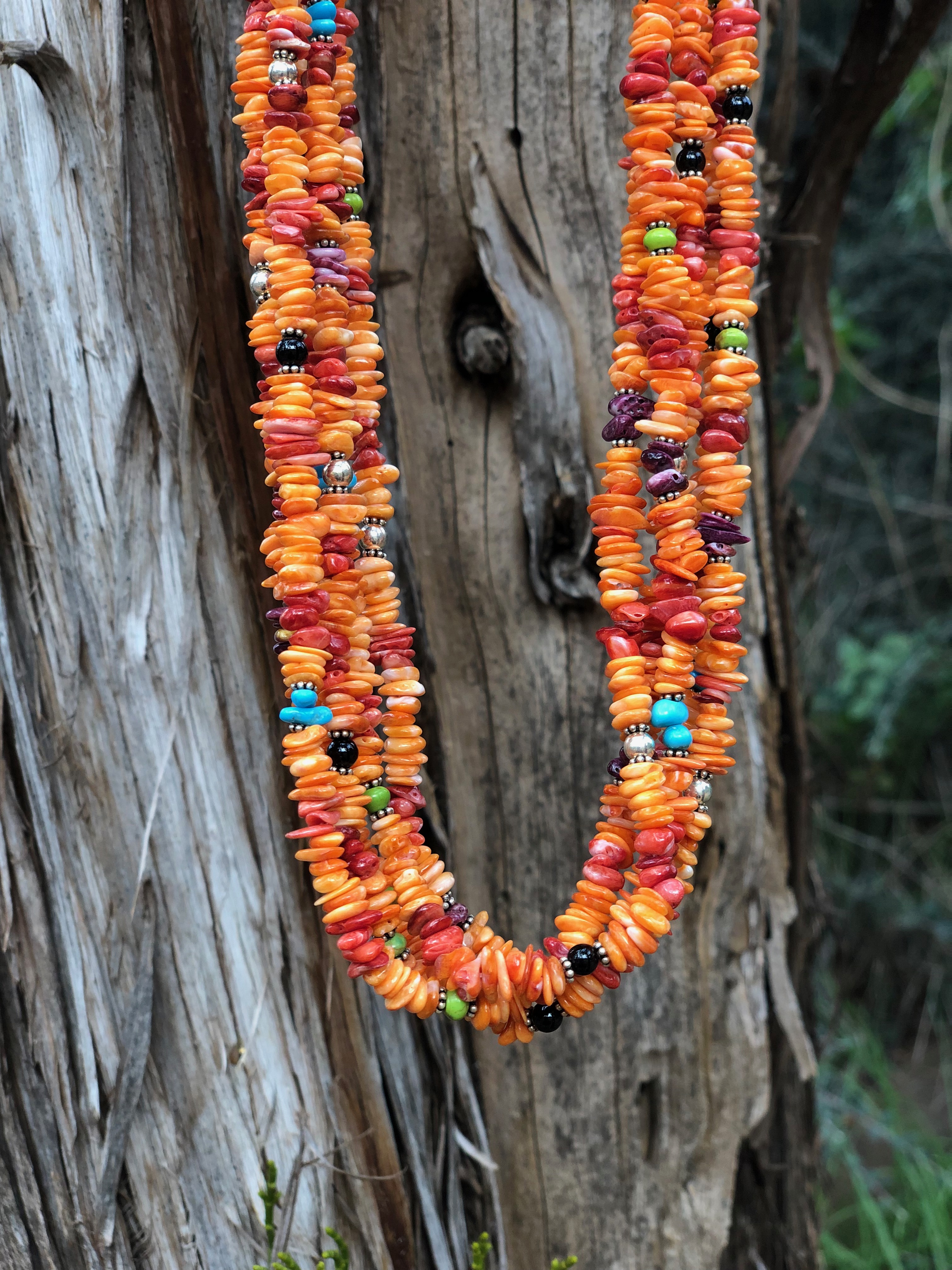 The spiny oyster shell is a bivalve and has been used in jewelry by Southwest Native Americans for roughly 900 years. Also known as a spondylus they are found around the world but change in appearance. The shells used by Native Americans come out of Baja California. This spiny oyster ranges in color from a bright orange to a deep purple, depending on its diet.
The spiny oyster shell is a bivalve and has been used in jewelry by Southwest Native Americans for roughly 900 years. Also known as a spondylus they are found around the world but change in appearance. The shells used by Native Americans come out of Baja California. This spiny oyster ranges in color from a bright orange to a deep purple, depending on its diet.Sugilite
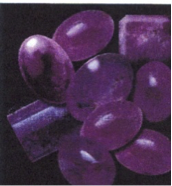 Sugilite was first discovered in 1944. The most important occurrence was found in 1975 in the Kalahari Desert, Northern South Africa. It is opaque with a waxy luster and ranges from a pale grayish lavender to a deep dark purple. Sugilite ranges 6 – 7.5 on the Moh’s scale of hardness. Folklore, Legend, Healing Properties: It is said that sugilite strengthens the heart, aids physical healing and reduces stress.
Sugilite was first discovered in 1944. The most important occurrence was found in 1975 in the Kalahari Desert, Northern South Africa. It is opaque with a waxy luster and ranges from a pale grayish lavender to a deep dark purple. Sugilite ranges 6 – 7.5 on the Moh’s scale of hardness. Folklore, Legend, Healing Properties: It is said that sugilite strengthens the heart, aids physical healing and reduces stress.
Sunnyside Turquoise
![]() Sunnyside turquoise has a very unusual and distinctive coloring to it. It ranges from dark blue to greenish with matrix that is golden brown to black. It is a very hard turquoise in its best grades and is fairly hard to find as the mine was mostly played out in the 1970’s. The Sunnyside mine is located in northern Nevada near the town of Tuscaroa in the Tuscaroa mountain range.
Sunnyside turquoise has a very unusual and distinctive coloring to it. It ranges from dark blue to greenish with matrix that is golden brown to black. It is a very hard turquoise in its best grades and is fairly hard to find as the mine was mostly played out in the 1970’s. The Sunnyside mine is located in northern Nevada near the town of Tuscaroa in the Tuscaroa mountain range.
Tiger eye
Tiger’s eye is usually a metamorphic rock that belongs to the quartz family. Tigers eye has bands of golden to red-brown color, with a silky luster. It got its name because it resembles the eye of the tiger. A member of the quartz group it has been used in jewelry for thousands of years. Most tigers’ eye comes out of South Africa but also in the U.S.A. Tigers eye is a hard stone being a 7 on the Mohs scale. It is said that tiger’s eye provides confidence and mental focus to the wearer.
White Buffalo
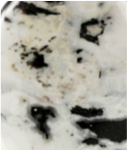 This beautiful stone was discovered near Tonopah, Nevada by the Otteson’s and it was given the name “White Buffalo turquoise” by them. Unfortunately this is not a turquoise and is intentionally misrepresented by unreputable stores trying to make an easy sale. The composition of this stone is Calcite, Quartz and Chert. White Buffalo is quite hard, takes on a nice shine when polished and will go with anything you wear. This mine closed in 2007. The original stone called “White Turquoise” is known as “Dry Creek” or “Sacred Buffalo” turquoise which also comes out around Tonopah, Nevada.
This beautiful stone was discovered near Tonopah, Nevada by the Otteson’s and it was given the name “White Buffalo turquoise” by them. Unfortunately this is not a turquoise and is intentionally misrepresented by unreputable stores trying to make an easy sale. The composition of this stone is Calcite, Quartz and Chert. White Buffalo is quite hard, takes on a nice shine when polished and will go with anything you wear. This mine closed in 2007. The original stone called “White Turquoise” is known as “Dry Creek” or “Sacred Buffalo” turquoise which also comes out around Tonopah, Nevada.
Wild horse
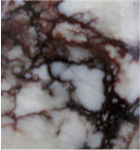 Wild horse is a mixture of magnesite and hematite (an iron mineral) and is found in the Gila wilderness area in Southern Arizona. Wild horse has a 4.5 hardness rating on the mohs’ scale. Wild horse got it’s name because it resembles a spotted brown and white pinto horse. Generally the stone is very white with purple hued browns or rosy browns running through the white magnesite.
Wild horse is a mixture of magnesite and hematite (an iron mineral) and is found in the Gila wilderness area in Southern Arizona. Wild horse has a 4.5 hardness rating on the mohs’ scale. Wild horse got it’s name because it resembles a spotted brown and white pinto horse. Generally the stone is very white with purple hued browns or rosy browns running through the white magnesite.
